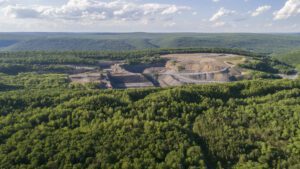Companies in the Mining, Minerals, and Metals industries face several traditional and new business challenges. The traditional and ever-present goal of reducing costs remains, but at the same time, these companies now face increasing pressure to gain visibility into the value chain, to become more agile, to optimize operational effectiveness, to meet market demand, and to increase efforts on sustainability. And, as always, safety can neither be sacrificed nor neglected.
One effective way to address these business challenges and goals is through implementing digital transformation. Digital transformation is not necessarily one large “rip-and-replace” initiative but can be the process of gradually — and in manageable steps — implementing new technology across the enterprise and supply chain to improve business processes and systems, as well as significantly reduce business risk and cost. Ultimately, this means executives will be able to proactively address business challenges strategically, rather than reacting to events or issues. Figure 1 shows how these steps can evolve from tactical to strategic addressing more systemic and more complicated problems as maturity grows.

Control Room to Integrated Operating Center & Workforce Demands
It can be argued that people are a company’s most valuable asset. Like companies in many other industries, those in the Mining, Minerals, and Metals industry face several challenges in recruiting and retaining a workforce qualified to improve overall enterprise performance. Digital transformation, especially as technology matures, can play a crucial role in addressing these fundamental challenges.
For instance, Mining, Minerals, and Metals companies face both an aging workforce and challenges recruiting qualified new professionals. At the same time, the nature of the industry is that in the search for higher-grade deposits, mining operations are located in remote locations and countries — far away from metropolitan areas. This trend further exacerbates the challenge.
There are two primary ways digital transformation can address and even remedy the situation:
- The use of digital technology allows people to exchange and receive information in real-time, rather than relying on printed spreadsheets, exchanging emails, or worse, phone calls.
- As a company moves through a digital transformation, it can create an Integrated Operations Center to manage operations from a central to a remote location. This way, for example, operations managers in urban areas can use technology to manage mine operations in remote areas. This technology appeals to millennials because it means they can live and work in urban areas rather than remote sites where mines are located. This, in turn, makes it easier for companies to recruit millennials and then retain them as they progress in engaging career paths.
Integrated Operating Center to Excellence Center
Companies that are higher on the maturity curve and ready to address today’s industry challenges can gain help from a center of expertise. This center of expertise consolidates plant information across multiple sites and even commodity groups. In turn, it promotes sharing best practices and benchmarking and fosters collaboration across numerous operating teams because it provides data sharing and data transparency to gain visibility across the enterprise.
Business Excellence Center
The center of expertise concept, essentially, consists of two core parts. The first is the Business Excellence Center (BEC). This consolidated entity integrates overarching business objectives and operating facilities to support business drivers. Spanning the mining value chain, it unites financial, industrial optimization systems, operations, and workflow systems with plant assets and, importantly, employees. In other words, by breaking down silos of operation, the BEC integrates business and technical competencies, so an organization can significantly improve enterprise performance.
Here’s how it works. The BEC fundamentally is a shared service with far-ranging responsibilities. Typically, they include establishing technical guidance, engagement framework, identifying and distributing best practices, benchmarking, fostering collaboration, and consolidating KPIs aligned with corporate objectives, financial and environmental constraints, and even operations targets. By enabling skilled personnel with the diverse domain expertise to collaboratively work in a centralized environment that – in turn – leverages business, technical, and operations expertise, the company can gain meaningful and actionable business intelligence.
Commodity Expertise Center
The other half of the equation is to create a Commodity Expertise Center (CEC), which focuses on a single commodity within the business. The CEC typically focuses on areas such as commodity market intelligence, real-time commodity-relevant KPIs, process benchmarking, advanced process operation, commodity supply chain optimization, and resource to market visibility.
This is important: Creating a CEC enables operations — whether remote or local — and the centralized teams in the CEC to collaborate. Essentially, it narrows the gap between business and operations information flow. As a result, the CEC can provide commodity groups with much-needed business intelligence that is focused on shared requirements and challenges — in near real-time.
Importantly, because the CEC integrates mine and process operations, it enables visibility into the entire supply or value chain. Often, mining companies are not able to address the entire mine-processing value chain. Consequently, for example, they are unable to optimize the operation or identify bottlenecks. On the other hand, creating a CEC delivers the type of visibility organizations require so they can become agile and optimize mining sequences or operations to meet fluid market demand.
How to get started
Download this e-Guide today to learn more about how integration and digitalization create collaborative business and operations environments for enhanced business performance in resources industries.




Conversation
Very well explained. Thanks for sharing such an informative blog.